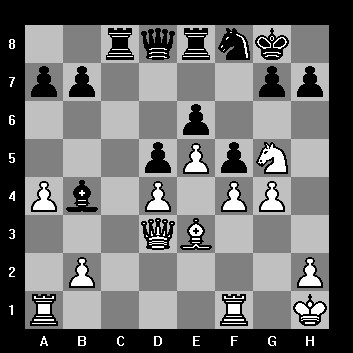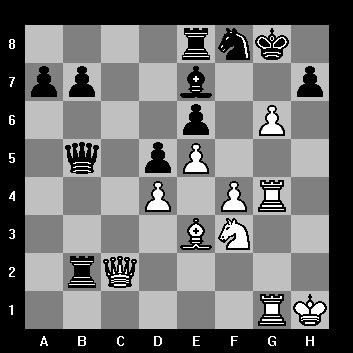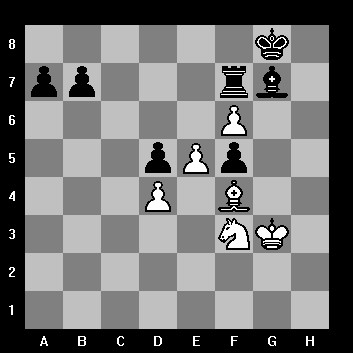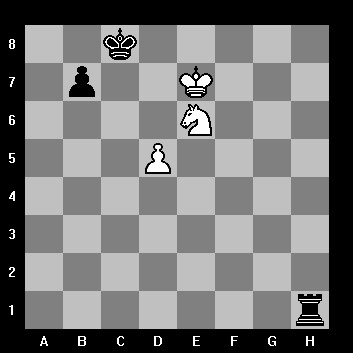24.09.2006
Game II V.Topalov - V.Kramnik
1.d4 d5 2.c4 c6 3.Nc3 Nf6 4.Nf3 dxc4 5.a4 Bf5 6.e3 e6 7.Bxc4 Bb4 8.0-0 Nbd7 9.Qe2 Bg6 10.e4 0-0 It's been known for already many years, that acceptin a pawn sacrifice after 10...Bc3 11.bxc3 Nxe4 12.Ba3 forces black to castle long - right under white's attack. 11.Bd3 Bh5 12.e5 Nd5 13.Nxd5 cxd5 14.Qe3 Bg6 15.Ng5 Re8 It's all well known till this moment. Black has no "bad pieces", but his position is rather constrained.15.Ng5 Re8 In case of Bxg6 black takes with the f-pawn obtaining counterplay on the opening file.

16.f4 White prepares an assault planning g2-g4.16...Bxd3 And here comes the novelty, previously 16...Rc8 and 16...Nf8 was played. Both this replies are strongly met with 17.g4! 17.Qd3 f5 18.Be3 Somewhat unexpected. In the first turn moves 18.g4!? and 18.Qb5 would strike an eye. Yet 18.Qb5 looks like going somewhat astray, after 18...Qe7 19.Qxb7 h6 20.Nh3 ( after 20.Nf3 reply 20...Nxe5 is not bad) black can for example play 20...a6 preparing a "perpetual" to white queen and draw. 18.g4 is interesting, but very risky: after 18...h6 white has to sacrifice a knight by one of some possible ways] 18...Nf8 19.Kh1 Rc8 20.g4!

Very strong! This "edition" of exploding the position is more justified than two moves ago. Black is not to be envied.20...h6 is dubious because of 21.Nxe6 Rxe6 22.gxf5 followed by 23.Rg1 with mighty pressure on g-file. 20...fxg4 only helps white to open the files: 21.f5 Be7 [21...exf5 22.Qxf5 favours white (white has a dangerous initiative also after 22.Rxf5 ) 22...Qd7 23.e6!] 22.f6! [more peaceful 22.Nxe6 Nxe6 23.fxe6 Qb6 24.Qf5 leads only to slight advantage.] 22...gxf6 23.exf6 Bxf6 24.Nf7 with strong attack, for example 24...Qe7 (24...Kxf7 25.Bg5) 25.Nh6+ Kh8 26.Nxg4! Bg7 27.Ne5 Nd7 28.Nf7+ Kg8 29.Bh6.Thus black is likely to be forced to play passively, e.g. 20...g6 21.Rg1! ( 21.gxf5 exf5 giving the knight e6 square is premature) 21...Be7 22.Nf3! (not allowing the knight exchange), and initiative is clearly on white's side.
20...Qd7 Perhaps, this is more precise than considered above 20...g6 with the same defensive purpose, because it doen't give white an instant target - g6 pawn may be attacked with white h-pawn advance.
21.Rg1 Be7 22.Nf3 Rc4 Black doesn't have any counterplay other than on c-file, but white's initiative on g-file and the kingside together with big space advantage appear to be of more significance.23.Rg2 [it was possible to chase the rook away by including 23.b3 Rc6 , but Topalov is not distracted by such trifles as an a4-pawn.
23...fxg4 24.Rxg4 Rxa4 Vladimir Kramnik piks up the gauntlet! Black is going to counter a fierce assault, and whatever in the future, he has provided himself with an extra pawn - just in case. 25.Rag1 g6 26.h4 Rb4
27.h5 No good defence is obvious now: 27...Qb5 28.Qc2 Rb3 [28...Rxb2 29.hxg6 Rxc2 30.gxh7+ Kxh7 31.Rg7+ Kh6 32.f5+ Kh5 33.f6 winning] 29.hxg6 h5 30.R4g2! [30.g7 hxg4 31.gxf8Q+ Kxf8 32.Qg6 Qd3 33.Qh6+ Kf7 34.Rxg4 Rg8 35.Qh5+ Kf8 36.Rxg8+ Kxg8 37.Qe8+ Bf8 38.Qxe6+ leads to a draw by perpetual] 30...Rxe3 31.g7 Nh7 32.Qg6 and white wins.
27...Qb5 28.Qc2 Rb2 29.hg6
In view of the variations given above the following line appears to be forced: 29...h5 30.g7 hxg4 31.gxf8Q+ Kxf8 32.Qh7 (32.Qg6 Qe2 33.Qg4 Bg5 leads to the same position) 32...Qe2 33.Qh8+ Kf7 34.Qh5+ Kf8 35.Qxg4 Bg5 36.Re1 with complicated position in which white's chances are higher.

29...h5 30.g7 hg4 31.gfQ Bxf8?? Terrible mistake! 32.Qg6+?? And a courtesy in reply! It's astonishing that both opponents missed not extremely difficult 32.Rxg4+ Bg7 33.Qc7! ,and black gets checkmated ] 32...Bg7
33.f5! In spite of white's error his attack remains very dangerous.[ 33.Ng5 looks weaker, yet after 33...Re7 white can both force draw by repetition of moves by immediate 34.Qh7+ Kf8 35.Qg6, or prefer 34.Rg4!? increasing the pressure and still preserving the mentioned draw maneuver for the worst case.] 33...Re7! Best defence[both 33...Qd7 34.Ng5 and 33...exf5 34.Ng5 Qc6 35.Qf7+ Kh8 36.e6 led to black's failure] 34.f6 Qe2 35.Qxg4 Rf7 And now 36.Qh5! keeps white attack rolling.
36.Rc1? Now the game looks like drawish.Correct was 36.Qh5! a5 (It's difficult to suggest anything better: 36...Qxe3 37.Ng5 is bad) 37.Rg3! (white has excellent winning chances in case of 37.Bh6 Rb3 38.Qxf7+ Kxf7 39.Rxg7+ Ke8 40.f7+ Ke7 41.f8Q+ Kxf8 42.Rg2+ Ke7 43.Rxe2 Rxf3 as well. However unpleasant black pawns are, a bishop is a bishop) 37...Qxe3 38.fxg7 Rb1+ 39.Kh2 Rb2+ 40.Kh3 Rxg7 41.Ng5 Qf4 42.Qe8+ Qf8 43.Qxf8+ Kxf8 44.Nxe6+ Ke7 45.Nxg7 a4 46.Nh5 and white must win
36...Rc2 37.Rxc2 Qd1+ [Perhaps it was better not to let white king out of the corner.37...Qxc2 looked safer.] 38.Kg2! Qxc2+ 39.Kg3 The king has come to support his army. The position is likely to become incredibly sharp again! 40.Bf4?! A crazy endgame could arise: 40.Qxe4! dxe4 41.Ng5 Bf8 (41...Bh6 42.Nxf7 Bxe3 43.Nd8 is in white's favour) 42.Nxe6 Most probably white pawns will be more dangerous than the black ones. 40...Qf5 Black could move his passed pawn forward 40...a5, but Vladimir seeks for a clear solution - transferring the game to an ending in this case is less dangerous for black than in the previous variation. Now presumably the strongest moves for both sides lead to a beautiful draw: 41.Ng5 Rc7 42.Nxe6 Rc3+ 43.Kh4 Qh7+ 44.Kg5 Bh6+ 45.Kh5+ Bg7+ 46.Kg5
41.Qf5 ef5

42.Bg5 Topalov strengthens his wedge on f6. 42.fxg7? would be useless because of 42...Rxg7+ 43.Bg5 a5 , and black is close to a victory. Matters are much more complicated with the move 42.Ng5!? For example, the following variation is interesting: 42...Bf8 (42...Bxf6? is bad: 43.Nxf7 Kxf7 44.exf6 Kxf6 45.Bc7 winning) 43.Kh4 a5 44.Kh5 a4 45.Kg6 a3 46.Nxf7 a2 47.e6 a1Q 48.Nh6+ Kh8 49.e7 and white wins. Correct for black is 42...Rc7 with an unclear position.42...a5 43.Kf4 a4 44.Kxf5 a3
45.Bc1 It would clearly favour black playing 45.Nd2 a2 46.Nb3 Rc7 47.e6 Bxf6 48.Kxf6 Kf8 with possible continuation 49.Ke5 Rc2 50.Kd6 Ke8 51.Bf4 Rb2 52.Na1 Rb1 53.Nc2 b5 and white is helpless against the forthcoming b-pawn advance. Now black can win by means of 45...a2 46.Bb2 Rc7 47.e6 Bf8 48.Ng5 Bd6 49.Kg6 Rc6 , but to find this at the board, especially the last two "computer moves", is very difficult. 45...Rc7 is weaker. After 46.Bxa3 Rc3 47.Ng5 Rxa3 48.fxg7 white may perhaps obtain counterplay enough to save the game.
45...Bf8 Kramnik's idea is clarified by the variation 46.e6 Rc7 47.e7 Be7 48.fe7 Rxe7 49.Bxa3 Re3 and black must win step by step.46.e6 Rc7 47.Ba3 Ba3 48.Ke5

48...Rc1 48...Rc2 or 48...Rc3 was possible approximately with the same ideas, white will respond with Nf3-g5 anyway. 49.Ng5 [49.Kxd5 loses to 49...Rf1 50.e7 Bxe7 51.fxe7 Kf7]
49...Rf1?! An errror, correct continuation would be intermediate 49...Rg1 forcing 50.Nf7, and only now 50...Rf1, and 50...b5! is even stronger: 51.Kxd5 Rf1 52.Ke5 b4 winning] 50.e7 Re1+ 51.Kxd5 Bxe7 52.fxe7 Rxe7 53.Kd6 Due to black king's being position far from the center white suddenly obtained reasonable chances for survival 53...Re1 54.d5 Kf8 55.Ne6+ Ke8 56.Nc7+ Kd8 57.Ne6+ Kc8 58.Ke7

59.Ng5? Striving for activity at any cost fails white It was necessary "to stay and wait": 59.Kd6 ] 59...b5 60.d6 Rd1 59...b5 60.d6 Rd1 61.Ne6 b4 62.Nc5 Re1 63.Kf6 Re3
White resigned
--------------------------------------------------------------------
Summary.
The second game happened to be even more interesting than the first one and was passing by a similar scenario scenario. Just like in the first game, Topalov was again the one to seize the initiative, but Vladimir Kramnik defended good. The game turned out to be exclusively tense, and unusually big number of mistakes for players of such a level confirms this clearly. The voltage raised so high, that on moves 31-32 both opponents missed a simple move immediately leading to white's victory. As it often happens in such cases, the one to lose is the one who is the last to err. This time Vladimir Kramnik made mistakes more rarely than his opponent, he "bore" an unpleasant attack by his opponent and went on to win the second game in a row. I think, chess fans are delighted - such an acute fight tension hasn't been seen for already a long time. At least, the last match of Kramnik (against Peter Leko) is by far incomparable to the current one by the spectacularity: there are no bloodless draws, and it's very interesting to follow the games. I am sure we can expect the forthcoming struggle to be no less thrilling.
